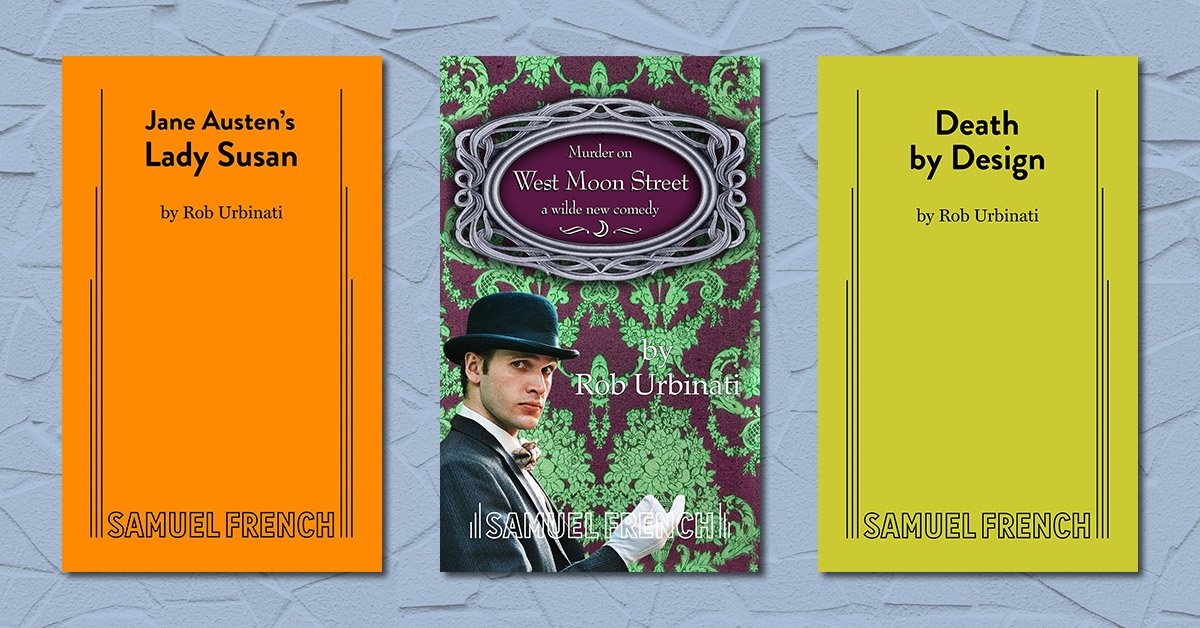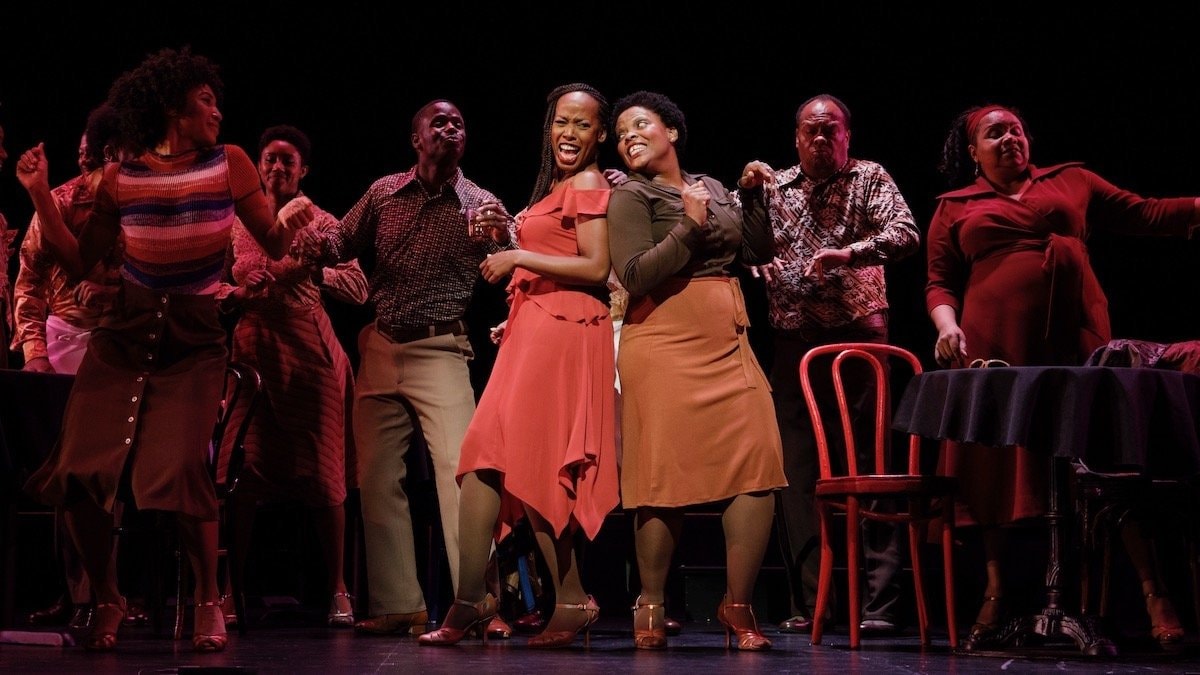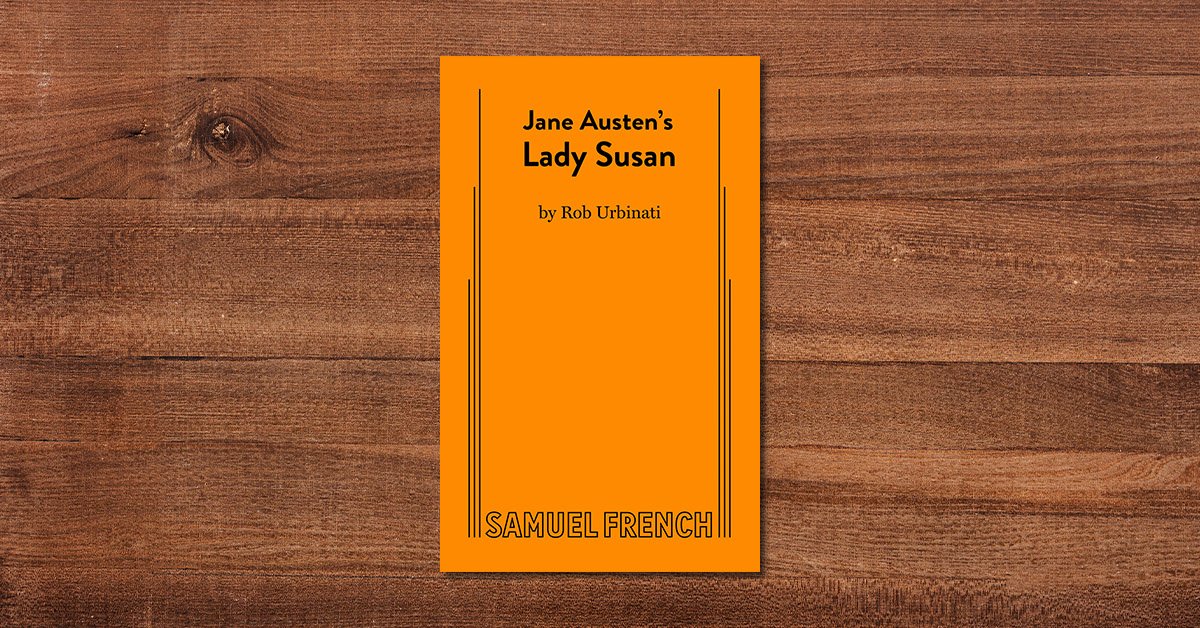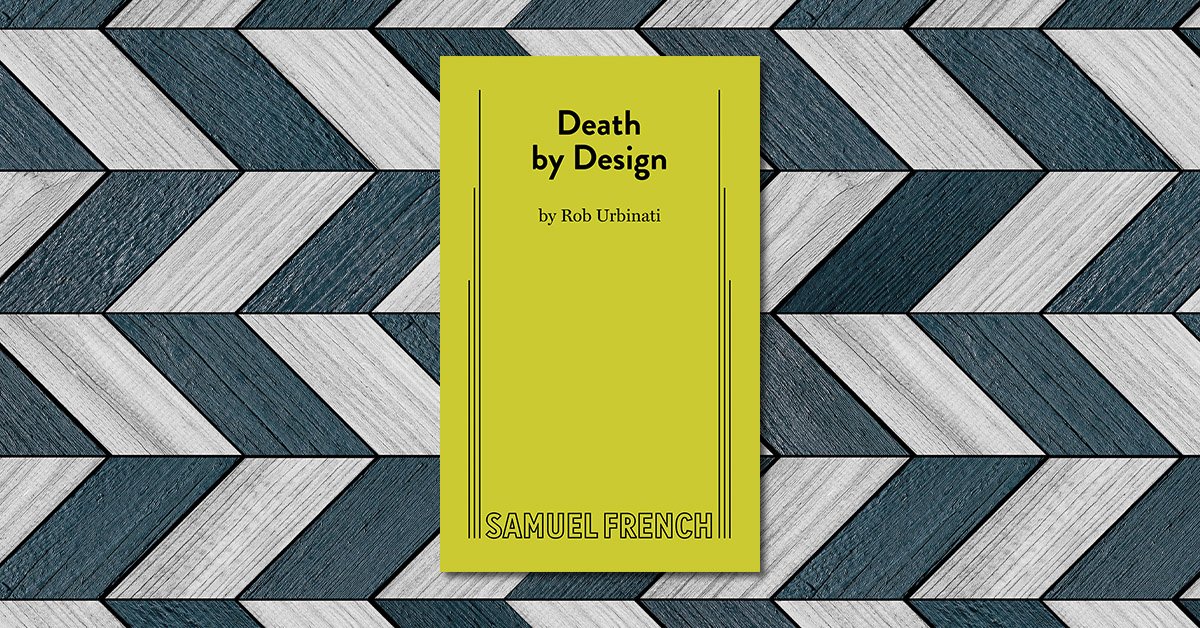
Playwright Rob Urbinati has penned several enormously popular titles in the Concord Theatricals catalog. His latest comedy, Jane Austen’s Lady Susan (US/UK), a witty adaptation of Austen’s 18th-century novella, recently wowed audiences and critics at Portland Maine’s Good Theater. Other hits include Murder on West Moon Street (US/UK), a stage adaptation of Oscar Wilde’s short story Lord Arthur Savile’s Crime, and Death by Design (US/UK), a wholly original murder mystery that comically “mashes up” the work of Noël Coward and Agatha Christie. We caught up with Urbinati to discuss these three “adaptation” plays, the enduring appeal of great works, and his approach to comedy and homage.
How do you choose material for your theatrical adaptations?
I love the tradition of British “high comedy” writers, from Congreve to Orton. With Murder on West Moon Street and Jane Austen’s Lady Susan, I deliberately chose novellas, rather than novels, by authors whose work I admired. There are some fine stage and film adaptations, particularly of Austen’s full-length work, but it’s less interesting for me as a writer to whittle down a major, well-known work of fiction than to introduce an obscure one. I can adapt more freely because most audiences are unfamiliar with the source material and come to it with fewer expectations. Both of the novellas have intriguing plots and a full array of compelling, eminently stage-worthy characters.
With these plays, you’ve dramatized three different eras (1800, 1891 and 1932), yet all three feel remarkably modern and fresh. How do you capture the atmosphere, attitudes and language of a particular era while retaining a contemporary voice?
Even though all three of my “style” plays are inspired, first and foremost, by the authors of the source material, ultimately, through multiple drafts, they’re written in my own voice, which borrows from various British comedy writers. There’s some Congreve and Sheridan, a lot of Coward and Wilde, and even Conan Doyle in my Austen adaptation. There are no anachronisms, but none of the plays are rigidly period, and all three have a more contemporary rhythm than those of the writers I adapted.
Also, the dramaturgical choices I make reflect contemporary sensibilities. For example, while much of Coward and Christie’s work includes servant characters, they are always minor figures. I wanted to foreground the servants in Death by Design, and have the audience see the rest of the zany characters from their perspective. In Wilde’s Lord Arthur Savile’s Crime, I was more intrigued by two women who are minor figures in the novella than by Lord Arthur himself, who’s a bit of a “tabula rasa.” I built up those characters and put them in conflict with each other for Sir Arthur’s attention. So, the play is more “inspired by” the source material than a “faithful” adaptation.
These plays are unique, but they share at least one trait: They are all very, very funny. Does comedy writing come to you quickly?
Thanks for the compliment! Alas, the comedy does not come quickly for me, unlike Coward, who wrote Private Lives in four days, and never changed a word. Finding the comic potential for each of the plays starts before I begin writing.
First, I read as much as I can of the author’s work to try and locate their distinct comic sensibility. For example, Wilde’s characters invariably say the exact opposite of what you would expect. In The Importance of Being Earnest, Lady Bracknell finds women who flirt with their own husbands “scandalous” because it’s “washing one’s clean linen in public.” With Coward, it’s the profound narcissism of his characters, as in a scene from Cavalcade, where fireworks go off on New Year’s Eve, 1899, and Mrs. Marryot’s babies begin to cry. She says, “How very rude of the Twentieth Century to wake the children.” It isn’t just that these two lines are funny, but they open a window into the authors’ distinct sensibilities, which I can then employ throughout the adaptations. With Austen, I borrowed heavily from many of the other British comedy writers because her work contains fewer overtly comic characters. So in Lady Susan, Alicia loathes the country estate where she finds herself, and takes every opportunity to criticize it, which is a Wilde trope.
Next, I select a “dramatis personae” for each play that includes at least a few overtly comic characters. Because the Wilde and Austen source material was obscure, I adapted freely, adding characters outright, or developing characters who were barely mentioned in the novellas. Next, I create moments in the plays where these characters are in situations which will support comic exchanges. Then, as with all comic writing, I select and weigh each word to be sure that it lands perfectly.
Lastly, I need to hear the dialogue with audiences. Here’s an example. I wrote a line for Alicia in Lady Susan that I thought was hilarious: She says to Catherine, who is perpetually prying into her affairs, “You’ll worm nothing out of me!” I was surprised to find that the idiom “to worm,” despite how contemporary it sounds, was actually used in Regency England. I assumed the audience would be in stitches, but after watching a few preview performances at Good Theater, it was clear that they did not share my enthusiasm. So, I went back to Alicia’s loathing for all things country, added one word, and the laugh I had hoped for was there: “You’ll worm nothing out of me, rustic!”
Your plays are remarkably easy to stage, with adaptable settings or single sets and a moderately small cast. They can be presented extravagantly or modestly. Is this something you consider as you write a new play?
It happened accidentally. Murder on West Moon Street takes place in multiple locations. In the New York production, directed by Davis McCallum, the scene changes were effortlessly quick. But I’ve seen regional productions where the changes were… not so effortless. So, I deliberately set out to place Death by Design on a unit set. I don’t know if that has something to do with why that play has been produced so often, but I didn’t take any chances with Jane Austen’s Lady Susan and set the entire play in a drawing room. In that play, there are a few scenes that really should take place in private rooms upstairs, but I was committed to a unit set.
Let’s dive into each of the shows, listed here chronologically by setting:
Jane Austen’s Lady Susan (set in 1800)
Adapted from the novel
Austen’s novel is epistolary, told exclusively through letters. How did you translate correspondence into action for the stage?
It took years. On the plus side, the letters gave me a clear sense of how the characters would speak (as Austen’s novels don’t contain a lot of dialogue, and when her characters do speak, it often sounds written). But I knew that the characters should not actually read or write letters, which can be dead weight dramatically. So, I took the content that was described in the letters and turned it into stage action.
The title character is daring, scheming and far less principled than other Jane Austen protagonists. In your play, she is more sympathetic, softening in the end. What made you choose this approach?
Apparently, Austen was inspired by Les Liaisons Dangereuses, and set out to write epistolary novel with cruel, manipulative characters. She never finished Lady Susan, maybe because she herself found her title character unappealing. I wanted to foreground the restrictions placed on women in Regency England which make Lady Susan’s conduct understandable. As a young widow with no son, she is not entitled to inheritance or property, and when her husband dies, all of this goes to her brother-in-law. To survive, she needs to find “suitable arrangements” for both herself and her daughter. In the novella, she takes delight in manipulation and cruelty for their own sake. In my adaptation, her behavior is a means to a necessary end, which makes her less selfish and more appealing. That said, she’s punished at the end of the play; She doesn’t land the man she wants, and her husband-to-be is a bit of a buffoon.
The play is remarkably efficient, with only seven characters and just a few settings, and you’ve structured the narrative so it all plays out in a single week. Did you have to reduce significantly from the novella?
The novella takes place over a period of years, like most of Austen’s work, and my first impulse when I decided to adapt it was to tighten the time frame considerably and create a kind of “hot-house” atmosphere where characters arrive unexpectedly, one after another, and where romantic entanglements are continuously being reshuffled as everyone shifts strategies. So I eliminated all of the events that occurred in London, before Lady Susan flees to her brother-in-law’s country estate, which constitutes the first third of the novella. This choice also forced the audience, and some of the characters, to speculate on what actually happened in London, rather than to possess this knowledge, which proved to be useful.
While reading the play for this interview, I laughed out loud several times. This line from Alicia, who loathes the country setting, is particularly hilarious to me:
SIR JAMES. I would follow Lady Susan to the ends of the earth.
ALICIA. You have arrived, sir.
Thanks! Once I settled on what would provoke Alicia to make irritable remarks (the country), I sought opportunities for how this could be exploited. As for Sir James, his infatuation with Lady Susan leads him to speak in exaggerated romantic platitudes. So I looked for ways to set their contrasting sensibilities against each other, and that’s how the exchange came to be. Note that Alicia’s loathing for the country has to have already been established for this line to work. Once her position on country living is made clear to the audience, she can drop in with lines like this wherever they’re suitable.
What do you think this play has to say to a modern audience? What can we, in 2022, learn from these characters from 1800?
I think that Carolyn Jack of The Jane Austen Society of North America said it best when I asked her to read the play: “Today’s women can easily understand that Lady Susan seduces and schemes because she has no options.” Contemporary women also have to fight for equal footing, just like Lady Susan. I think that my adaptation is a feminist work. There are other ways I try to have the play speak to 21st Century audiences, as when Lady Susan says, “What if my daughter and I become sick?” That line isn’t in the novella, but I wanted to include an indirect allusion to health care. That said, all of Austen’s work speaks to today’s audiences. Her detailed, realistic, complex characters are not that different from people we know – they just speak better! My goal is for audiences to view the plays through a contemporary lens, without updating them.
Murder on West Moon Street (set in 1891)
Based on Lord Arthur Savile’s Crime by Oscar Wilde
As with much of Wilde’s work, the humor in the original short story comes from the moneyed class’s inherent contradictions. In this case, Lord Arthur believes the “moral” thing to do is to murder someone. It’s a murky moral line, and you walk it brilliantly. How did you balance humor with social commentary and satire?
It was easier than I thought, mainly because Wilde is absolutely consistent. All of his humor grows out of the same idea, the one you reference – the inherent contradictions of the “moneyed class.” To situate this social critique in the context of comedies of manners is his gift, and I borrowed it outright for Murder on West Moon Street. The characters are completely oblivious to morals, but they are charming and witty. Wilde walks that fine line, and I followed.
Like Lady Susan, this play mines a great deal of humor from rivalry, particularly among the women. It must be fun to create these insults as you’re writing! Can you talk a bit about antagonism and its relationship to class and social standing?
With Murder on West Moon Street, I invented the rivalry between Sybil and Lady Windermere. Lord Arthur is not very bright and extremely susceptible, so I wanted two strong women pulling him in different directions. I created these women to be antagonists, which leads directly into rivalry, which prompts the insult humor. Even though the characters in both plays are of similar social standing, the slight differences in their class and tastes create openings for all manner of insults. While I confess it’s deeply satisfying to write these insults, I’m careful not to have the characters speak too cruelly about one another. I prefer that they insult each other’s furnishings or fashion sense.
You expanded the role of Lady Windermere, bringing her from the background of the short story to the foreground of the play. Why?
Even though she only makes a brief appearance in the novella, she was intriguing – more intriguing than Lord Arthur. In fact, all of the characters in the play are more interesting than the slow-witted protagonist. He’s Wilde’s sly critique of the “moneyed class” and the British education system. Because he’s a simple, ordinary, young man, I needed to surround him with a lively cast of characters, including his clownish cousin, an anarchist who considers himself an aesthete, a playfully ruthless doyenne of society, and so on.
Dramaturgically, on top of the central plot where Lord Arthur tries to do away with someone quickly so he can be properly wed, I wanted a larger thematic consideration of what type of life he would choose; Would he become one of Lady Windermere’s “lions” at her society gatherings, or live a quiet life in the country with Sybil? I think it’s important that these style plays contain more than just flowery language. All three are strongly plotted, so audiences, hopefully, are invested in the outcome, and not just wallowing in witticisms.
You also created or strengthened other female characters by adding cousin Jane, giving Sybil greater agency, etc. Why did you choose to expand the presence of women?
All my life, I’ve been surrounded by strong Italian women! I’ve written three plays (Hazelwood Jr. High, The Queen Bees and Ladies at the Spa) that feature only women, and my other plays have more women than men. Once I decided that Lady Windermere would be a major character, it was clear that someone needed to challenge her influence on Arthur. If I remember right, Sybil has one line in the novella. I wanted to flesh her out, give her agency, and put her up against Lady Windermere, a formidable opponent, and see where this would lead. I added cousin Jane simply because she created an opportunity for farcical comedy.
You altered the ending, reminding us we are watching a comedy. What are you hoping audiences will take away from the show?
Their personal belongings. But seriously, with these plays, what I want most is for audiences to laugh. That said, all three have social critiques buried beneath the comedy. Murder on West Moon Street exposes the privileged, amoral behavior of the upper class in Edwardian England. The only character with any morals at all is Charles, the manservant, who I invented (with some help from P.G. Wodehouse). With Death by Design, nearly all of the characters attempt to murder a conservative politician for their own selfish ends, mostly because he wants to end government funding of the arts. But are these aspiring murderers really people you’d want the government to fund? With Jane Austen’s Lady Susan, it’s the limitations placed on women in Regency England – and now.
Death by Design (set in 1932)
Inspired by Agatha Christie and Noël Coward
For this play, you didn’t directly adapt a single work. Instead, you created a “mash-up” of the works of Noël Coward and Agatha Christie. I can only imagine the amount of research required! How did you prepare for this amazing feat?
I immersed myself in both writers’ work. The similarities were striking, especially in their early work, which evokes England in the period between the wars. Also, they utilized the same types of characters.
Where did the idea come from?
I was out of town, directing, and went to a used bookstore. I love the covers of paperback books from the forties and fifties, and perusing the “C” shelf of the alphabetized stock, I bought a bunch of books by Coward and Christie, with amazing cover art. It wasn’t until I started reading them that their similarities became clear, and the idea to mash-up the two writers occurred to me.
Death by Design walks a line between homage and parody of an Agatha Christie murder mystery. How did you maintain that balance?
When I first began writing Death by Design, the plan was for the first act to be more Coward and the second act more Christie. But that early draft felt lopsided, and it became clear that a better choice would be to sustain the Coward style into Act Two. So I followed Christie’s oft-employed device of having everyone be a suspect, but pitched it toward comedy, so that the characters’ motivations are absurd, which is why the play feels like a lampoon of her work. That said, when we discover the motivation of the “murderer,” the play becomes serious, in a direct homage to Christie.
I love the twist you’ve spun on the traditional murder mystery: In this case, everyone suspects themselves of the murder! How did that come to you?
Because the suspects are all egotistical Coward characters, who would want to take credit for the murder!
The play is also available as a play with music. Death by Design: A Comedy with Songs and Murder (US/UK) contains two original songs by Peter Mills, written in the style of Noël Coward. How did the musical version come to be?
Most of Coward’s straight plays contain a few songs, and I wanted to follow this tradition. I’m a big fan of Peter Mills (who is married to Cara Reichel, Artistic Director of Prospect Theatre, where Murder on West Moon Street premiered), and asked him if he’d be interested in writing some songs in the style of Coward. A master at pastiche, Pete composed two lovely tunes with cleverly worded lyrics, which lift the language of the play to another level.
For more information about licensing Jane Austen’s Lady Susan, Murder on West Moon Street, Death by Design and other works by Rob Urbinati, visit Concord Theatricals in the US or UK.

The Truth Behind… The Normal Heart

Musical Revues




